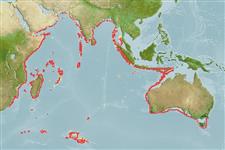Environment: milieu / Zona climática / intervalo de profundidade / distribution range
Ecologia
marinhas batidemersal; intervalo de profundidade 265 - 458 m (Ref. 58018). Deep-water
Western Indian Ocean: southern Indonesia (off the south coast of Java) and SW Thailand to India (off Chennai, Tuticorin and Kerala), the Gulf of Aden and off the coast of Somalia. Records from the Philippines, the South China Sea and elsewhere in the western Pacific Ocean are misidentifications.
Tamanho / Peso / Idade
Maturidade: Lm ? range ? - ? cm
Max length : 17.0 cm SL macho/indeterminado; (Ref. 95053); common length : 12.0 cm TL macho/indeterminado; (Ref. 9133)
Descrição suscinta
Chaves de identificação | Morfologia | Morfometria
Espinhos dorsais (total) : 10 - 11; Raios anais : 9 - 10. This species is distinguished by the following set of characteristics: lower jaw terminating in a distinct forwardly projecting horizontal plate with strong, spine-like processes directed forward from the plate’s corners; silvery grey body with numerous minute black spots and traces of broad darker crossbars; black colour at base of anterior dorsal fin spines and distal parts of dorsal fins; adipose fin tiny with numerous black spots; caudal fin black; 3.5 scales above lateral line; 3 rows of cheek scales; very large head, 34.3-40·1% SL; large eye, 29·8-40·8% HL; long pectoral fin, extending to beyond dorsal fin base, 21.7-26.2% SL; body silvery grey with minute black dots and traces of broad darker crossbars; operculum dark dorsally, silvery ventrally (Ref. 95053).
Body shape (shape guide): elongated; Cross section: compressed.
Found offshore (Ref. 30573).
Ciclo de vida ou comportamento de acasalamento
Maturidade | Reprodução | Desova | Ovos | Fecundidade | Larvas
Bineesh, K.K., K.V. Akhilesh, M.F. Gomon, E.M. Abdussamad, N.G.K. Pillai and A. Gopalakrishnan, 2014. Redescription of Chlorophthalmus corniger, a senior synonym of Chlorophthalmus bicornis (Family: Chlorophthalmidae). J. Fish Biol. 84(2):513-522. (Ref. 95053)
Status na Lista Vermelha da UICN (Ref. 130435: Version 2025-1)
Ameaça para os humanos
Harmless
Uso pelos humanos
Pescarias: pesca de subsistência
Ferramentas
Relatórios especiais
Baixar XML
Fontes da internet
Estimates based on models
Preferred temperature (Ref.
123201): 10.4 - 15.9, mean 11.8 °C (based on 61 cells).
Índice de diversidade filogenética (Ref.
82804): PD
50 = 0.5000 [Uniqueness, from 0.5 = low to 2.0 = high].
Bayesian length-weight: a=0.00191 (0.00096 - 0.00380), b=3.03 (2.85 - 3.21), in cm total length, based on LWR estimates for this species & (Sub)family-body (Ref.
93245).
Nível Trófico (Ref.
69278): 3.6 ±0.5 se; based on size and trophs of closest relatives
Fishing Vulnerability (Ref.
59153): Low vulnerability (11 of 100).
🛈
